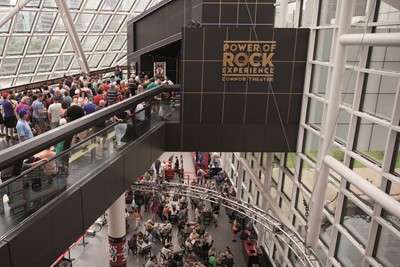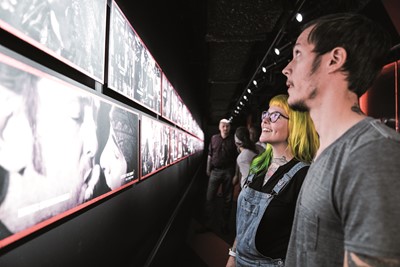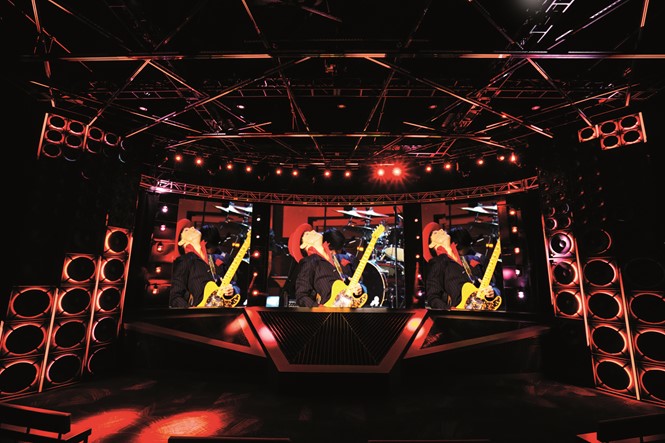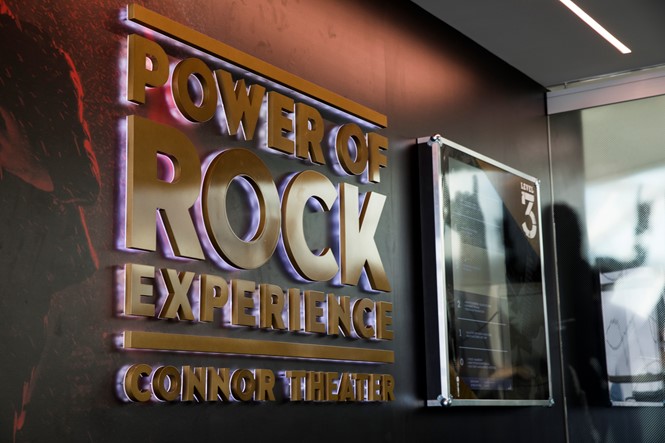Brand experience: Rock and Roll Hall of Fame
The institution at the heart of rock’n’roll has unleashed the power of rock from its reimagined theatre and museum. Brittany Golob talks music, technology and experience with the Rock and Roll Hall of Fame
In 1958, the godfather of rock’n’roll, Chuck Berry, released what would swiftly become an iconic track – covered by everyone from the Beatles to Jimi Hendrix to Judas Priest – and would contribute to Berry’s legacy and ultimate induction into the Rock and Roll Hall of Fame. In July 2017, the very same institution debuted a film experience that begins with a montage of Hall of Fame inductions, including none other than Berry’s ‘Johnny B. Goode.’
The film, directed by Academy Award winner Jonathan Demme, highlights that and other spine-tingling moments of Hall of Fame glory with the songs and artists most beloved by rock’n’roll fans the world over. It speaks to rock as a way of building connections, of reaching emotions and of crafting cultures. Those key characteristics were what the Rock and Roll Hall of Fame wanted to evoke when redeveloping its signature theatre experience.
President and CEO of the Rock and Roll Hall of Fame, Greg Harris, says the organisation recognised that it was time to change the mission statement it had been operating under since the 1990s. Previously, the goal had been to, “Legitimise that rock’n’roll was worthy of a museum, was worthy of study and that we were going to be the foremost authority,” he says. However, almost two decades later, that was no longer a dream for the future, but implied by the hall’s very existence. The new mission would be to, “Engage, teach and inspire through the power of rock’n’roll.” Harris adds, “The whole idea of making meaningful connections and broadening our reach was critical.”
To work towards this new mission, the Rock Hall charged Los Angeles-based experiential agency BRC Imagination Arts with reimagining the home of rock. BRC is no stranger to brand homes, having worked on everything from Dublin’s Guinness Storehouse to the Abraham Lincoln Presidential Library to the Kennedy Space Center. But the challenge presented by the Rock Hall was of facing a changed world of gallery design, reinvigorating an iconic building while retaining its heritage and attracting a different kind of consumer. “A lot has changed in the world of music, in the world of technology, in the world of experiential,” says BRC’s executive creative director and vice president, Christian Lachel. “What everybody recognised was the world of the audience had changed, the expectation of what audiences were looking for, and what the future of rock’n’roll was going to be.”
To address this, BRC and the Rock Hall first set about doing extensive research into customers and similar cultural sites. Research allowed BRC to better understand the audience and the ways in which festival experiences and modern technology have influenced the way people engage with and listen to music. The team realised the power of rock’n’roll as a connection between generations, between friends, between cultural tribes. “The power of connection was the thing that we really wanted to drive,” Lachel says.
The work then began on what would become the signature piece at the Rock and Roll Hall of Fame, the ‘Power of Rock’ film and experience. The Demme-directed film would take the place of an encyclopaedic, and exhaustive, two-hour long video featuring 330 Hall of Fame inductees.
Harris says the new film “runs 12 minutes, but brings you through the powerful emotions of rock’n’roll: freedom, heartbreak, love, excitement. It reminds you of every great show you’ve ever attended. You find yourself thinking of the people you were with when you saw certain artists, and it reminds you of how this music connects all of us.”
That’s a powerful notion for a 12 minute film. But it’s one that’s enhanced by Demme’s direction, by the integration of rarely released induction concert footage from the Hall of Fame’s archives and by the rest of the experience devised by BRC. Because, it’s not just a film.


The top floor of the Rock Hall now features a build up to the ‘Power of Rock’ which echoes a concert-like experience. It replicates the energy and emotion that swells before an artist takes the stage. The pre-show includes induction moments and the importance of the Rock and Roll Hall of Fame in music culture. That builds to a crescendo when visitors enter the Connor Theater and watch the short film. A film that caused a music journalist at the press night say to Lachel, “You’re a jerk. You made me cry twice! You really got the emotions.”
The film is followed by a digitally integrated post-show experience that allows visitors to virtually interact with some of the Hall of Fame’s biggest names and to leave their own messages in return. But, like any modern concert, the experience does not end when the lights go up or the curtain goes down. It is shared on social media, talked about with friends and posted on YouTube. Thus, the post-show content is all socially shareable.
The ‘Power of Rock’ is immersive and well-tailored to its audience. However, it is only one part of the revitalised Rock Hall experience. After the preliminary research was carried out, the team learned that the Rock Hall’s primary audience was not the group that was expected. Instead of, as Harris calls them, the ‘ageing boomer rock fans’ comprising the core audience, it was a demographic known as ‘music enthusiasts.’ This demographic likes immersive experiences, it likes the story behind the music, and it prefers engagement to historical fact.
That shift in mindset has allowed the Rock Hall to reinvent itself from the inside out. One major change was to its name – now simply known as the Rock and Roll Hall of Fame. Following that, a new colour palette was introduced using black, red and gold.
Lachel says BRC’s inspiration for the new colour palette are the authentic materials of rock music – the chromes and the metals, the blacks and the leathers, the reds and the wood grains. That tone influenced the graphics as BRC introduced bold visuals and strong statement headlines throughout the venue. But it also changed the approach to the overall brand experience. “Lighting has a concert like feel to it. Audio has always got to be dynamic and you can’t come to a music experience like the Hall of Fame and not have it,” says Lachel, adding of the copy style, “It should be written in a way that has the voice of rock’n’roll. It shouldn’t feel like we’re at the library looking at the historic manuscript of the Gutenberg bible. It should have the feel of, ‘Hey, this is Chuck Berry’s guitar.’”
The two other big changes to the Rock Hall, though, are both the most internal and most external aspects of the institution. The first, is to do with staff. Internal shifts took place organisationally, but staff were also brought along on the rebrand journey. They were retrained to foster a stronger sense of the museum’s identity and their role within it.
“What everybody recognised was the world of the audience had changed, the expectation of what audiences were looking for, and what the future of rock’n’roll was going to be"
Second, the most opportune chance to engage with visitors was, for 20 years, unrealised. The Rock and Roll Hall of Fame occupies an architecturally iconic building designed by I.M. Pei in 1983. In front of that structure is a large, open plaza that leads to the banks of Lake Erie at the museum’s flanks. That space has since been brought to life in the true spirit of rock’n’roll. The impetus for redeveloping the plaza came again from the audience segmentation and an understanding of how music has changed. Major festivals have become part of the music landscape, with sprawling fields, Instagrammable scenes and culinary delights. Taking that to heart, BRC installed three-foot-tall red block letters spelling out the legend, ‘LONG LIVE ROCK.’ They’ve since become one of the darlings of the Rock Hall’s social media. The plaza was also host to a summer concert series, complete with beer garden and food truck. But its crowning moment came when John Mellencamp was visiting his exhibit on 2 September. He jumped on stage and played an impromptu 10-song set. “It was just the moment we always imagined,” Lachel says.
The changes won’t stop there, though. The rest of the Rock Hall will be modernised in the next few years, with more integration of digital throughout. It is also sending exhibits off around the country and beyond after their initial seasons in Cleveland. And, in 2020, the Rock’n’roll Hall of Fame is set to open its first auxiliary site – in Tokyo. It’s a lot of change at once, but then, that’s simply a reflection of the state of the music industry over the past 15 years or so. Keeping the Rock Hall grounded will be its focus on its artists and its audiences, and the drive toward creating a successful experience.
Sixty years ago Chuck Berry and other artists started a revolution in music that would become rock’n’roll. It has evolved over the years and it has expanded and it has drawn in new audiences. It has shifted from in experience as technology has changed from record players, to headphones, to concerts and festival stages, to MTV, to YouTube, to Spotify. Like its namesake, the Rock and Roll Hall of Fame has changed and evolved but it will never forgo its lifeblood: great music, emotional connections and powerful experiences.
For more from Transform magazine, follow us on Twitter @Transformsays














